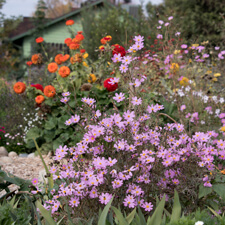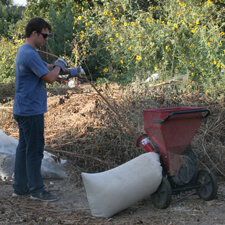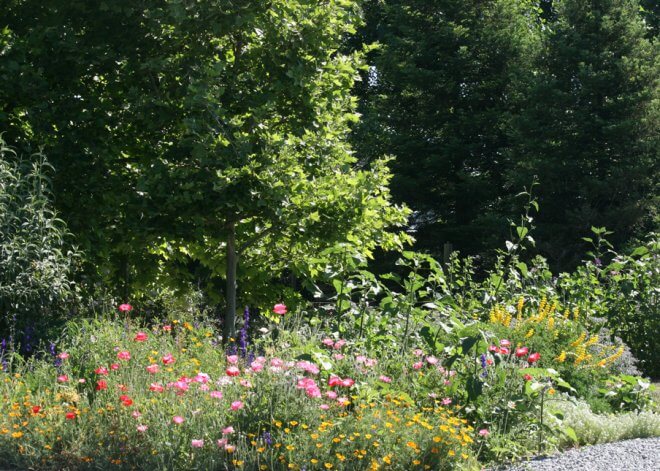


Sheet Mulching
I don’t dig it. At least not anymore. I used to dig in amendments endlessly to make plants happy in my high-alkaline, heavy clay soil. It didn’t work very well, to say the least. Then I discovered sheet mulching (also known as lasagna gardening) and I have never looked back. And my back is so much happier.
Sheet mulching is essentially composting directly in the garden bed – whether for the vegetable or ornamental garden. And it’s so easy. You just pile on the layers of amendments and then leave it to the worms and bugs to turn it over for you. As they work their magic, the materials decompose and flatten.
I got my start by reading about Lasagna Gardening in Mother Earth News. It resulted in wonderfully crumbly soil and thriving plants. Besides creating better soil, it also smothered the endless bank of weed seeds that I was battling.
How to Get Started
Evaluate the current weeds. Really noxious weeds like Bermuda or nut grass can grow through practically anything. So you should remove them before getting started. If the area is dry, be sure to wet it before starting to layer.
If there are weeds in the area that you want to smother, you can cover them with cardboard. If you are a Costco member, their big flat cardboard liners are the easiest to use. At my local Costco, they will let you go down the aisles and put them on a cart to take for free. These are so much easier to use than breaking down boxes. Plus they are all about the same size and don’t have any printing or tape/labels on them. Be sure to use multiple layers of cardboard and overlap them to keep weeds from growing through any openings.
Some gardeners use newspaper, but I have found cardboard to be much easier to use. If you do choose to use newspaper, be sure to discard all the slicks and anything else with heavy use of color inks.
Whether you use cardboard or newspaper, it will decompose along with all the other layers. After I lay them down, and each layer of amendments, I thrown down a sprinkler to moisten each layer.
Amendments
You can use practically any organic material but just like with a compost heap, don’t include any protein (fat, meat or bone). My amendments have included:
- Pigeon manure it’s always near the bottom because it’s got a lot of uneaten seeds (plus it stinks and attracts flies). I pull whatever germinates but always keep the peas because they add nitrogen to the soil. It’s a cold manure, so I don’t have to wait for it to rot.
- Gypsum – great for alkaline, clay soils
- Starbucks coffee grounds – they give away big bags for free.
- Pine needles
- Sprinkling of bone/blood meal
- Leaves – Not just mine, I scavenge from my neighbors’ yards too.
- Shredded flowers, branches, etc.
- Kitchen scraps
- Grass clippings (no seeds) – mix with other browns (leaves, straw*, etc.)
You can also include:
- Straw* or soiled hay
- Seaweed or kelp meal
- Sawdust
- Hulls or husks
- Lime – great for acidic soils
- Compost
*If you use straw, know your source. A lot of straw comes from RoundUp Ready crops – meaning that it has been saturated with glycophosphate. You might be okay with this for an ornamental garden, but not for a veggie garden.
What amendments should you include?
It may depend on your type of soil. For example, those with acidic soil might also want to include lime. But otherwise, I recommend using whatever you already have on your property, can get from your neighbors or in your community. It’s a good idea to get your soil tested so that you’ll know if/how to sweeten the mix.
Consider the composition of your various components. For example, too much brown/carbon material (like leaves or straw) can rob the layers of nitrogen. Conversely, too much greens (like kitchen scraps or cut grass) can make the layers slimy. I tend to mostly have browns, so that’s why sometimes I throw in some bone/blood meal to balance the amendments. Do keep in mind that different plants need different levels of nitrogen. In areas with drought-tolerant native plants, I am less than concerned about the level of nitrogen (they typically don’t need as much) as areas where I am growing nursery cultivars (like bulb flowers or dahlias).
In some areas of my yard, like under my roses, I try to do a layer of sheet mulching every year. We just finished the beds and right now the layers are about 4″ or so high, but over the coming year as the amendments decompose and is digested by worms, it will flatten. It makes my roses very, very happy and I can see the difference in years that we have not put down a fresh layer of sheet mulching.
To minimize any of my layers from blowing out of place, I usually place a top layer of organic soil. Often I use Kellogg’s organic soil (bagged) because it’s mostly micro bark. It’s really hot and dry in my area, so the micro bark acts like a little layer of mulch. Yet, it’s small enough for seedlings to grow around it.
But in large areas, I’ve covered the sheet mulching with yards of planter’s mix soil and/or forest hummus. I really like forest hummus because it also acts as a mulch to protect the plants roots from the hot summer sun.
Sprinkle Sheet Mulching
In many areas of my yard, there are many plants that are closely planted, plus various wildflowers transitioning in and out throughout the year. In these areas, there is never a time that I can completely cover the area with sheet mulching to reinvigorate the soil.
So throughout the year, I just sprinkle layers of amendments. I’ll thrown down some coffee grounds, bone/blood meal, shredded leaves/spent flowers, etc. This serves three purposes:
- Fertilizes as it slowly decomposes into the soil.
- Minimizes watering.
- Insulates the roots of plants, flowers and trees.
It’s brutally hot during our summers and my plants, trees and flowers really benefit from ongoing mulching throughout the year. In my experience, clay soil should not be exposed. It always performs best when mulched.
Besides all the benefits to my garden, sheet mulching keeps us recycling virtually everything we trim from our plants and trees. The only thing we put out for the garbage trucks: noxious weeds or diseased plants/branches.
If you don’t own a chipper, you can save up your leaves and branches and then rent one to shred your yard waste. We did this initially but we had so much that it became more cost effective to buy one.







Hello,
Thanks for the great content! I was thinking about sheet mulching my large back lawn and sowing a wildflower meadow. My plan is to put down a layer of cardboard, then a layer of mulch over the entire backyard. However, I have a question about when I can sow my wildflower seeds. I’ve read I need to wait an entire year and I’ve also read three months. Can I sow seeds directly into the mulch after three months? Thanks!
Hi Rachel, I’ve not heard of waiting to sow after mulching. With cardboard and mulch, I can’t think of any reason why this would be necessary. I only would wait if I were using amendments (like poultry manure, leaves, etc.) that need time to decompose. Otherwise, I immediately sow the wildflower seeds over the mulch. However, it depends on your zone as to when to sow wildflowers. In Western states of US, wildflower seeds are ideally sown in the fall; though I do it from fall to January. Hope that answers your question. 🙂
Thank you so much! This is great news! I should have mentioned I’m in Tacoma Washington :).
Great! Then you’ve got plenty of time to get ready. Let me know how it goes!
Straw used for fall decor, is it usually ok to use?
Hi Donna, It’s hard to tell the source of straw. It could be from a roundup-ready crop. So I would use it for ornamental gardening, but unless I knew its source, I wouldn’t use it for a kitchen garden. 🙂
Thanks for explaining this great idea of sheet mulching. I will definitely incorporate it into my garden. I lasagna style my compost pile (as you saw in my IG post) and then distribute by the bucketful but I want to try sheet mulching on my roses.
Don’t forget to include the Mary Lou Heard Memorial Garden Tour in Southern California first weekend in May. http://Www.heardsgardentour.com is FREE (donations go to @Sheepfold) and is the only ‘real Gardens by real people’ tour that I know of. The 40-ish volunteered yet vetted gardens are all over Orange and LA counties and must be done by the gardener and not by professionals. You’d love it!
Hi Miriam, I hope your roses love sheet mulching as much as mine! I’ll be sure to include the Mary Lou Heard garden tour. Thanks!
Thank you, gardening-for-purple
You’re welcome! 🙂
I was so happy to come upon your website! I have access to free leaf compost in our town (live in Western NY). I want to do sheet mulching to prepare a wildflower meadow. I have put about 4-6 inches of compost down on top of our mowed yard (which is pretty much clay soil…….), will then put cardboard or some other paper mulch down, then more compost & shredded leaves over top. This will occur in October. I am hopeful that I can simply throw wildflower seeds on the prepared area with no tilling or other preparation come April once risk of frost is gone. Am I being too simplistic in thinking this will work?? Is there another step I should take before snow falls?
This sounds like a good plan. But depending on conditions, you may want to put down some mulch over the leaves. This holds down leaves in windy weather plus wildflower leaves like to grow in the nooks and crannies of mulch. Many tree trimmers will give you mulch for free. 🙂
Can I use shredded paper, leaves and garden soil to build up a bed?
Absolutely. I use all of these in my sheet mulching. 🙂
Thank you for the Costco and Starbucks as resources!